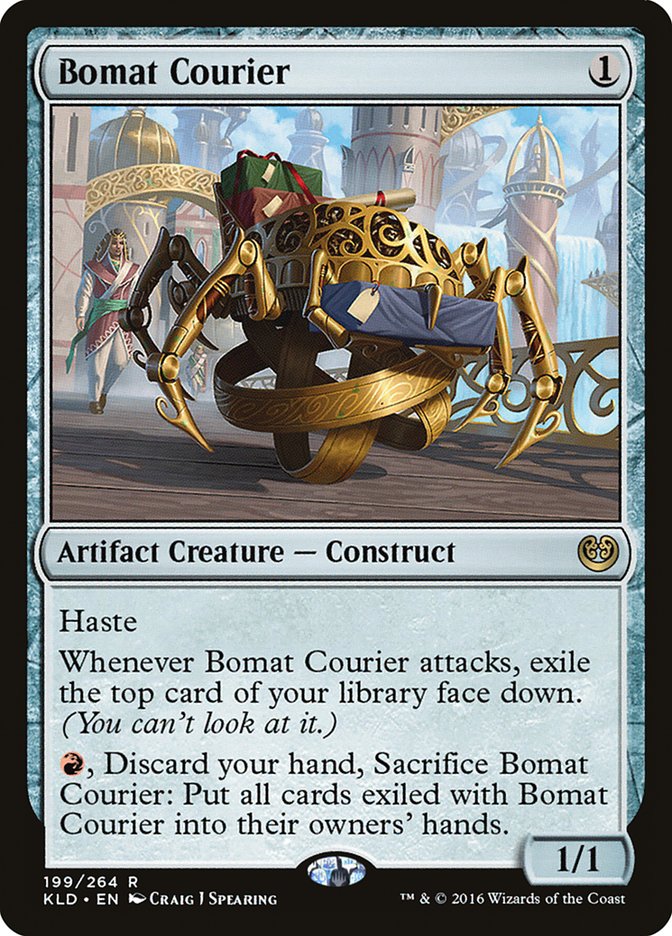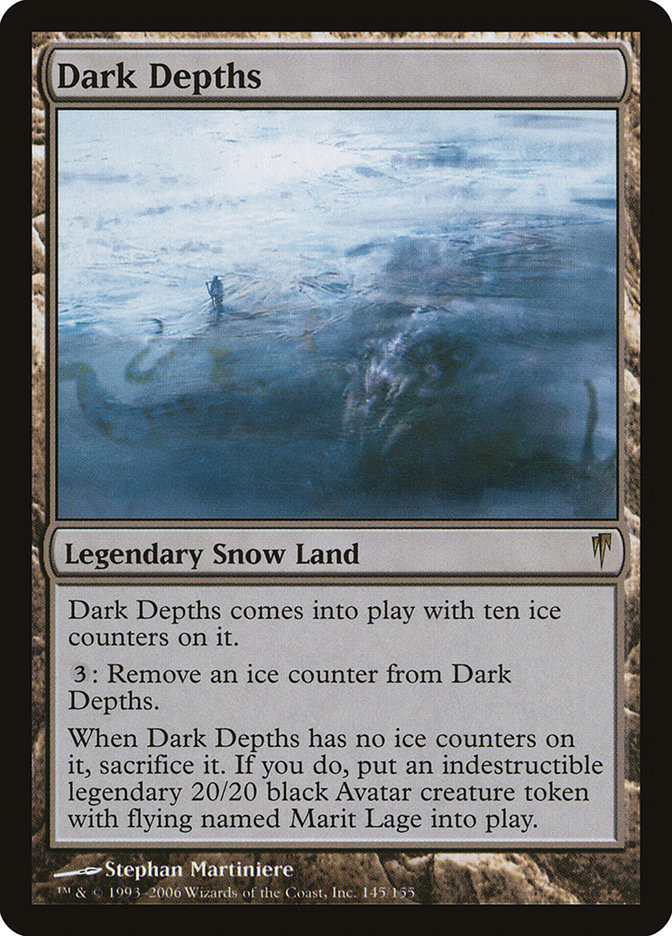Legacy is in a strange place these days. Crushed between the fair blue
package of Deathrite Shaman, Brainstorm, Force of Will, Ponder, and friends
on one side and the one-sided Chalice of the Void, Blood Moon, Dark Depths,
or all-in combo decks on the other, it would seem like the format is slowly
approaching a death spiral for innovation. Most high-level tournament
results seem to bear out the same story, at least on the surface. But
scratch a little deeper, look a little harder, and you can still find bold
explorers trying all manner of twists and variations to squeeze out an edge
in the Cadillac of Magic formats.
Bomat Courier Isn’t Just for Standard Anymore
Never let it be said that Grixis Delver isn’t the tried-and-true top deck
in Legacy at this point. The stock list, developed mainly through
word-of-mouth among the best pilots, like Bob Huang, Noah Walker, Dylan
Donegan, and a host of others, is absolutely incredible. It’s a well-oiled
machine, down to the usual two maindeck Spell Pierces and single maindeck
Forked Bolt. However, some bold innovators consistently try to make
something new and different happen to throw opponents for a loop, and Zan
Syed’s Bomat Couriers are the best of the bunch.
The theory behind the card is solid. A deck that lacks true sources of card
advantage often runs low on gas against the other fair decks of the format,
and lowering the average converted mana cost of the deck to better deploy
spells while disrupting via Daze and Force of Will is almost always a good
thing. By replacing True-Name Nemesis and Spell Pierce, cards that are
generally known, with additional must-kill threats, Zan has brought Grixis
Delver a totally new game plan that many folks won’t be ready to answer.
Everyone has their Toxic Deluges, their Diabolic Edicts, or their Marsh
Casualties at the ready to make True-Name Nemesis look a little silly.
Well-informed folks aren’t often running their expensive non-creatures into
untapped mana unless they have literally no other choice. This means that
A) you can bluff Pierce more often than ever before, and B) you’re often
demanding the same specialized removal spell with a one-mana card as you
did with a three-mana one.
A hand of Bomat Courier, Daze, two Force of Wills, two random blue cards,
and a single land is incredible and will generally result in a bunch of
free disruption followed by a quick refuel without ever needing to get
above a single land. Compared to a slower, ponderous three-mana threat, a
threat for which people have time to find their specific answer, Bomat
Courier seems like a slam-dunk change-up.
“But wait!” you say. “Bomat Courier is so bad against Deathrite Shaman!
Why, it doesn’t attack through a Deathrite at all! If the opponent has a
Deathrite Shaman and you don’t have a way to keep parity or answer it,
you’re going to lose!”
Uh, I thought we just got done discussing how you already almost always
lose to an uncontested Deathrite Shaman in the fair deck mirrors. Of
course, an early answer for Deathrite is practically mandatory, and the
common play prioritization for Deathrite mirrors involves usually killing
an enemy Shaman as soon as possible. Bomat Courier does little to change
this, other than leaning in even harder and admitting that it’s really,
really, really important to answer opposing Shamans so that your little
draw engines can do their work.
When that creature warps the format so hard
that the mirror match is practically defined by who has more answers for
it, it’s okay to sigh and make yourself even more vulnerable to being
behind on Deathrite parity. Oftentimes when both players have a Deathrite
Shaman, the player with a Bomat Courier can manipulate the Deathrite war to
force the opponent to tap their Shaman at an inconvenient time, sneaking in
the robot mailman for an extra card or two.
There are, incidentally, two cute side bonuses for Bomat Courier in Grixis
Delver. One is the fact that with fetchlands, a well-practiced player can
figure out what cards lie under their Bomat at any time. Just take a look
through the deck and (quickly, if possible) see how many Force of Wills,
Lightning Bolts, or whatever other key card are still in there. Process of
elimination is a beautiful thing. Obviously on MTGO this is way easier, but
some real cardboard practice can make this trick rather painless.
Additionally, Bomat Courier offers another avenue to victory against the
hated Blood Moon decks. A few Force of Wills, Bomat Couriers, Young
Pyromancers, and Lightning Bolts can still put in the necessary work to
drag home a win against an early Moon. It’s not easy, but a little extra
equity is never a bad thing.
One final note before the decklist: It’s important to understand that Bomat
Courier often dramatically changes your play patterns when piloting Grixis
Delver. Where before it was often important to carefully husband your Force
of Wills to counter the last (or most important) spell possible, now there
is huge motivation to just fire that bad boy off on the first juicy target.
You want an empty hand to fill with fresh cards, and you want to use your
free counterspells to keep the road clear for your Courier, so spending a
Force of Will on that Deathrite Shaman, Baleful Strix, or other random
durdle is way, way more desirable in Grixis Courier. Get hellbent, then get
restocked. It’s cool to have a single card incentivize us to just chuck old
card advantage paradigms out the window in favor of battlefield presence.
New incentives to change our play patterns are what keeps this game alive
and dynamic!
Creatures (16)
Lands (18)
Spells (26)
- 4 Brainstorm
- 4 Lightning Bolt
- 4 Force of Will
- 4 Daze
- 1 Cabal Therapy
- 4 Ponder
- 1 Forked Bolt
- 4 Gitaxian Probe
Sideboard

It would be reasonable to add the third Young Pyromancer back in the
maindeck over either the fourth Bomat Courier or the single Cabal Therapy,
and the sideboard could change to include a Pithing Needle, a Diabolic
Edict, a Marsh Casualties, a Grim Lavamancer, an Umezawa’s Jitte, or
possibly a Dismember or Fatal Push to address a weakness to Tarmogoyf. I’m
a firm believer, however, in the value of proactive disruption like
Thoughtseize over the traditional inclusion of a Flusterstorm or additional
Pyroblast. The choice of Abrade vs. Ancient Grudge is also up for debate,
as the added flexibility competes with the potential for a powerful
two-for-one against a deck like Death and Taxes. In order to properly
address the theoretically unfavorable matchup against Czech Pile, a package
of Bitterblossom and/or Liliana, the Last Hope is practically mandatory.
Regardless of specific choices for the sideboard, the advent of a powerful
source of card advantage is a great reason to start thinking more about
what outdated technology might still be lingering around in a calcified
format like Legacy.
Medium Depths is Surprisingly Better Than The Name Implies
Speaking of calcified technology, there are now three distinct ways to make
a 20/20 in this format. The traditional Lands archetype is powerfully
grindy with the potential to assemble a quick win if the opponent makes a
misstep. Turbo Depths cedes the potential to lock out an opponent for a
dramatically increased percentage of turn-two Marit Lages, as well as a
hefty helping of discard to improve traditionally weak matchups against
Storm and Sneak and Show. But a few weeks ago, Jody Keith showed the world
that there wasn’t quite a need to go all-in on the 20/20, and that it was
eminently possible to play a fair package of Deathrite Shamans and Dark
Confidants instead of Lotus Petals and Elvish Spirit Guides.
Enter Medium Depths. It’s not too fast, not too slow, just the right speed
to get the job done while being extra-resilient to the all-too-common
Diabolic Edicts that litter sideboards as a prophylactic measure against
Marit Lage. Here’s the list I played at Grand Prix Toronto this past
weekend with Hunter Cochran and Andrew Jessup as my trusty Standard and
Modern copilots.
Creatures (15)
Lands (23)
Spells (22)

There’s a lot that can be done with the Medium Depths shell. One can play
Tarmogoyf to supplement the fair game plan, as the big creature is nearly
unkillable for most Grixis Delver lists. Tireless Tracker is excellent, but
alone it’s a bit slow. A complete gearshift into a midrange creature
strategy would be truly interesting. Living Wish is a strong option that I
simply did not have time to explore, as is a Ramunap Excavator or two. More
Marsh Casualties are certainly useful against decks like Elves and Death
and Taxes. The fact remains, though, that a cross between Aggro Loam,
Lands, and Turbo Depths is possible and can certainly be tuned to be a
contender in contemporary Legacy. The common idea here is to weave your
lists around the common answers people are preparing for the angle of
attack they anticipate and exploit their unpreparedness. This is why rogue
innovations can pay off so handsomely; many opponents won’t know how to
sideboard or what cards to counter against an unusual cross between two
different known strategies.
Deathrite Shaman into…Blood Moon?!
Speaking of unusual crosses between strategies, the final innovation to
speak of this week is Wilson Hunter’s Grixis Moon deck, which he used to
great effect against Delver and Czech Pile decks all weekend. I didn’t get
his precise list, but my reverse-engineering from playing against him
produced this rough sketch:
Creatures (11)
Planeswalkers (1)
Lands (15)
Spells (33)
- 4 Brainstorm
- 3 Lightning Bolt
- 1 Counterspell
- 4 Force of Will
- 2 Diabolic Edict
- 1 Mountain
- 2 Island
- 3 Cabal Therapy
- 4 Ponder
- 2 Thoughtseize
- 4 Gitaxian Probe
- 1 Kolaghan's Command
- 2 Fatal Push
Sideboard

The idea is a generally potent plan against Marit Lage decks with all the
Edicts, Moons, and Dead//Gones, and a plan against the other fair midrange
blue decks of “keep pace, slam Moon, lock them out in the midgame.” It’s
ceding the powerful Delver/Wasteland/Daze triumvirate that separates blue
tempo from blue midrange in Legacy, and in exchange gaining relative
immunity to opposing Blood Moons as well as the opportunity to use some of
its own. This tradeoff ebbs and flows in popularity, with similar plans
like Back to Basics in straight U/W Miracles gaining steam at the moment.
Learn to respect suspicious basics out of blue midrange decks. If your
opponent is packing more than two basics, there’s a decent chance they
could lock you out at some point in the midgame. Exploiting opponents who
don’t think of Blood Moon against an ostensibly fair Deathrite Shaman deck
is one of the many ways to get an asymmetrical edge in pseudo-mirrors.
Bomat Delver. Medium Depths. Grixis Pyro. These are three of the major
Legacy innovations that merit attention, ways to improve in a format that
has largely gone unnoticed in the wake of the seemingly unstoppable Modern
juggernaut. Use them to gain an edge over those who will stick to the same
fundamental strategies with few frills or fancy tweaks. At the very least,
keep experimenting, lest you fall into lazy patterns that leave you
flat-footed when someone else breaks it.






